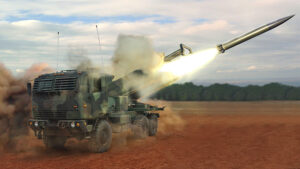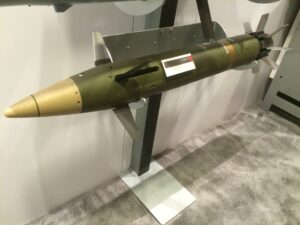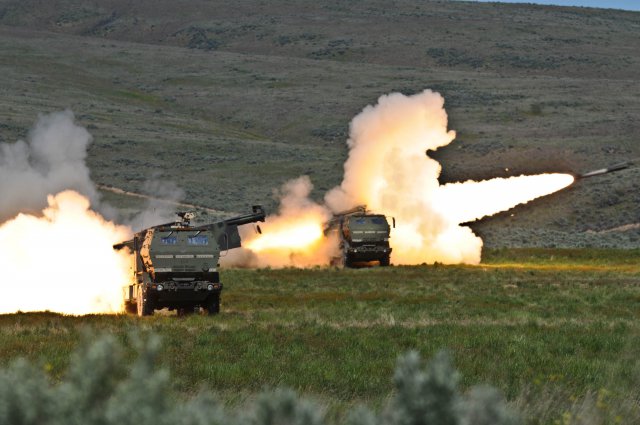Raytheon Targets Army Multi-Domain Systems Like DeepStrike [Sponsored]
Posted on

Raytheon’s version of the Army DeepStrike missile system. Artist rendering
As the new National Defense Strategy shifts the U.S. armed forces’ focus from combating violent extremists to confronting China and Russia, Raytheon is offering an array of multi-domain capabilities to modernize the Army “not just for today but tomorrow,” Kim Ernzen, executive vice president of the company’s Land Warfare Systems, says.
Raytheon is particularly well positioned to meet one of Army Chief of Staff Gen. Mark A. Milley’s key priorities – improving the Precision Strike Missile (PrSM) capabilities, Ernzen adds.
The company already meets the Army’s needs for precision fires today, with its widely fielded Excalibur 155mm artillery round. “We just recently received another nearly $100 million contract to produce additional Excaliburs,” Ernzen says. “The Army definitely is using them in theater today, having great success with it. It’s a great weapon. It has GPS, has long range. Definitely a go-to projectile for the Army.”
As is the case with a number of Raytheon-produced ground combat weapon systems, “Excalibur is one that has seen significant plus ups,” she says. The recent contract is for about 1,500 projectiles and “we expect to see more late this year, going into ’19.”

Raytheon’s Excalibur N5 smart artillery shell
Raytheon also is working intensely to fill another of Milley’s top priorities, a guided rocket system with longer reach and greater capacity than the vintage Army Tactical Missile System (ATACMS), an improvement that is urgently needed to counter the long-range systems fielded by potential peer adversaries.
Army Gen. Curtis Scaparrotti, NATO’S Supreme Allied Commander and the head of U.S. European Command, told Congress March 8 that American forces would be “out-ranged and out-gunned” in a conflict in Europe, an apparent reference to Russia.
Raytheon is aiming to help them avoid that problem with its $116.4 million contract for the Army’s DeepStrike program. “It’s a competition between us and Lockheed Martin,” Ernzen says. “The whole purpose is to provide long-range capability.”
The Army wants a system that can reach out about two times ATACMS’ roughly 100-mile range.
“Right now, the thing that is really exciting is that it will absolutely attack the overmatch threat with maximum range,” Ernzen says. “And it will increase the lethality, the load out, because the currently configuration of ATACMS is only one round per pod. This will definitely increase their capability to be more flexible.”

Army HIMARS trucks launch GMLRS (Guided Multiple Launch Rocket System) missiles
ATACMS can be fired from either the heavy track-propelled M270 launcher, which holds two rounds, or the truck-mounted HIMARS launcher, which holds one rocket. DeepStrike’s requirements are to double that load and be compatible with the existing launchers.
Another requirement is the ability to hit moving targets on both land and sea, a key element of the multi-domain thrust.
“We’re ahead of our schedule. The first flight tests are scheduled for next year. We want to continue to push on speed to market, because that is one of the critical elements for the Army, being able to field that asset as quickly as possible,” Ernzen says.
Making the system more resilient and able to function in a denied environment is a key part of Raytheon’s approach. “That’s one of the biggest things that the Army is facing, since they’ve been at war for nearly two decades in a very different type of war. It’s been very limited. And as they start to look at this pivot that’s happening in Eastern Europe and going back into what we would consider more of a conventional war, they recognize that, unfortunately, they have to regain some of the advantages that they definitely had.
“We (Raytheon) continue to invest in some of these technologies to give us the ability to insert them into products, ones that are existing or that we are developing, to be able to address some of these key things that the Army — and specifically the chief of staff — are focusing on,” she added.
An example of that, Ernzen says, was Raytheon’s investments in improvements in their anti-tank missiles. “We continue to look at the warhead’s lethality, and address some of the countermeasures that are on those tanks. We’re investing in those kinds of technologies to enhance the lethality of the systems.”
“We’re always looking at seeker technologies” and better systems “to see the hidden areas of battlespace, and pick out the target better.”
An example of that latter goal is Raytheon’s development of a third generation FLIR sensor.
“What third-gen technology does, is combine a mid-wave and a long-wave infrared emission. It gives longer distances, to enhance the range of view that the sight can see from the vehicle.” That “helps attack the overmatch capability that we currently are seeing in the battlespace.”
Combining these two IR waves “enhances your lethality in the battlespace,” including improved adverse weather performance, she added.
Raytheon is under contract to deliver “the B kit,” which essentially is the eye of the FLIR sight that gives enhanced low-light capability to the commander’s primary sight and the gunner’s sight on the M-1 Abrams main battle tank, Ernzen explained. “This is really going after enhancing, or upgrading, this battlefield package on the Abrams.”
Ernzen noted that Raytheon is able to sell many of its systems to U.S. allies and partners, which “helps offset costs for the Defense Department, to help keep their contracts competitive.”
Subscribe to our newsletter
Promotions, new products and sales. Directly to your inbox.
